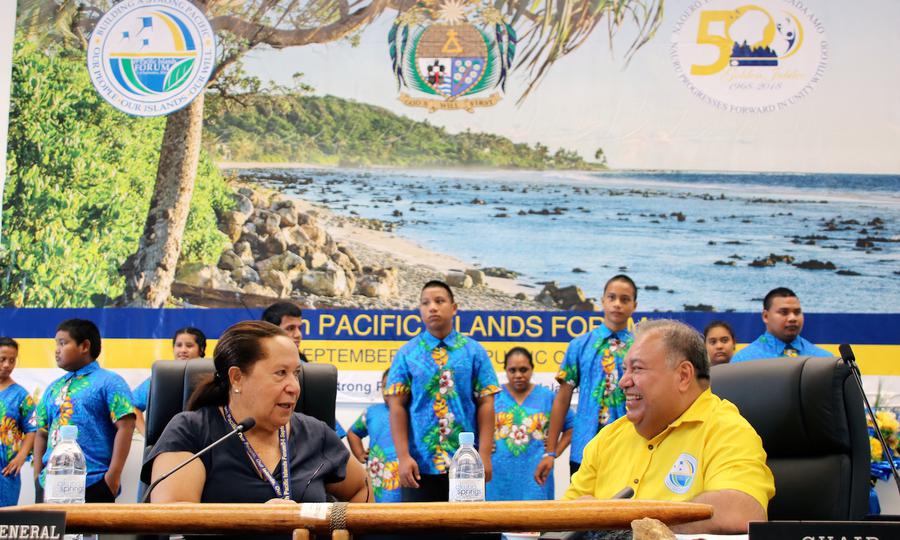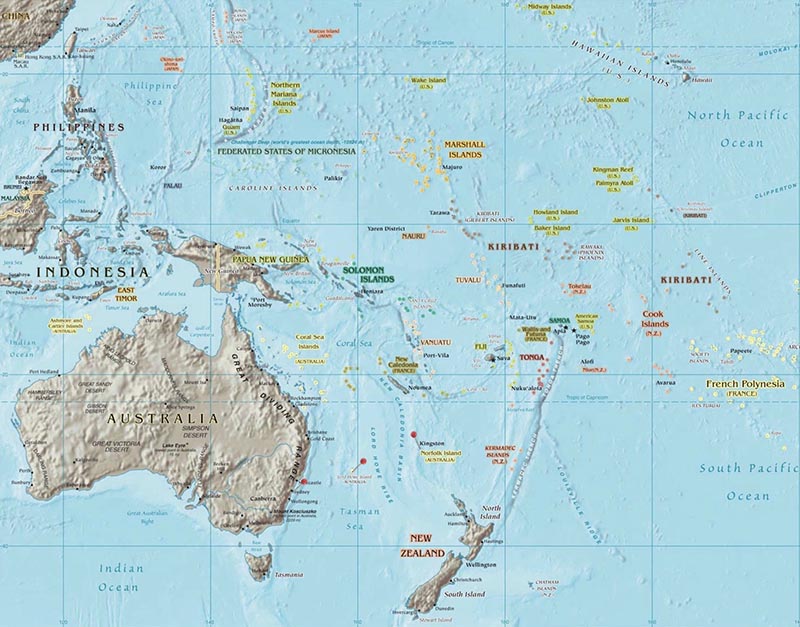[Analytics] EU offers aid alternatives for island nations

Meg Taylor, left, secretary-general of the Pacific Island Forum, and Nauru's President Baron Waqa, right, attend the 'Small Islands States' meeting ahead of the Pacific Islands Forum on Nauru in Sept 2018. Talks focused on the threat from climate change and China's rising influence in the region. Photo: AFP / Mike Leyral
Europe is providing island nations in the Pacific with a third “Western option” – after Australia and the US – when considering funds for infrastructure or development projects, including moves to manage climate change. Emanuele Scimia specially for the Asia Times.
Foreign development assistance to the South Pacific has been in the spotlight over the past year as the United States has repeatedly accused China of using financial aid and concessional loans to Pacific islands for geopolitical purposes. Whether these allegations are true or not, the EU’s model of financing for developing countries offers a stark alternative to Chinese funding.
A recent meeting of the Asia Development Bank in Fiji revealed that the European Investment Bank (EIB) and European Union financial institutions have been assisting Pacific island countries, notably states with ties to France and Britain.
Green investments
Luca Lazzaroli, director general and deputy head of operations in the Operations Directorate of the EIB, noted that geographic, economic and institutional factors constrain the development of small islands, particularly in the South Pacific. As a result, they are more exposed to external economic forces and vulnerable to the impact of climate change.
Lazzaroli said the EIB would continue to provide Pacific islands with competitive long-term financing for climate action projects, especially for initiatives such as climate-resilient infrastructure, support for environmentally-focused small and medium enterprises and renewable energy. The EIB believes it is the world’s largest lender for climate-related investment projects and a global leader in issuing green bonds.
The EIB official went on to say the bank supported projects with strong development potential. It promotes economic stability, sustainable growth and employment opportunities to alleviate poverty. Central to this effort is the cooperation in the South Pacific area with other development partners such as the ADB and the World Bank.
An EIB spokesperson told Asia Times that since the beginning of its activities in the Pacific in 1963, the bank has signed loans in the region totaling more than US$786 million.
EIB financing in the Pacific islands has accelerated over the past decade. From 2006-19, project approvals totaled about $374 million, of which $12 million are yet to be signed and just over $158 million are yet to be disbursed.

According to the Sydney-based Lowy Institute, the EU as a whole directed $738 million worth of loans at the Pacific islands from 2011-18, making it the seventh-largest donor in the region. China ranked second at $1.3 billion, while Australia led the pack with $6.6 billion.
Most EIB-funded projects were approved in overseas territories of France and Britain, but there has been increased diversification to other Pacific island nations such as Papua New Guinea, Fiji, Samoa and the Solomon Islands.
Sustainable projects
European institutions are committed to backing projects that are financially, socially and environmentally sustainable. The question is whether this approach is more attractive to the Pacific islands than that of China.
Beijing does not attach overt political strings to financial assistance, in the sense that it does not require recipient countries to meet democracy, transparency, environment or human rights standards. However, Chinese export credit agencies such as the China Exim Bank link loans to the participation of Chinese contractors and require a certain percentage of materials, equipment and services to come from China.
The US government says China’s concessional loans to fragile Pacific islands are a “debt trap.” In the US view, the Chinese deliberately fund unsustainable transport projects in poor countries, which are then forced to repay loans with national assets, especially strategic infrastructure that can help increase the projection of the People’s Liberation Army Navy.
Beijing includes the South Pacific in the Belt and Road Initiative, its plan to boost connectivity and trade integration across Eurasia and beyond. According to the congressional US-China Economic and Security Review Commission, this suggests China has geostrategic interests in the region, as it seeks naval access from Japan to Palau. US dominance in the area prevents the Chinese navy from sailing freely in the Western Pacific.
The Rhodium Group research firm said in a recent paper that concerns about the sustainability of China’s model for project financing in developing countries were legitimate, but “suspected inflation of project budgets or sub-optimal project planning” leading to high debt exposure to Chinese policy banks was limited. The research firm suggested asset seizure as a form of debt repayment had occurred in only a few instances: Sri Lanka’s Hambantota port and perhaps 1,158 square kilometers of land in Tajikistan. The authors of the report pointed out that in most cases Beijing had renegotiated or written off the debt of its partner countries.
Cristelle Pratt, deputy secretary general of the Pacific Islands Forum Secretariat, recently said that Pacific islands had a “friends to all approach” when negotiating passage between competing superpowers. This tactic gave them a wider range of development options.
In this respect, the existence of alternative financing sources like the EIB helps increase the bargaining power of Tonga and Vanuatu, which are struggling to repay debts with China.
Despite their differences, there is room for cooperation between EU financial institutions and China in the South Pacific. The EIB already co-finances a number of infrastructure projects in Asia funded by the Beijing-backed Asian Infrastructure Investment Bank.
For EU authorities, the AIIB is evidently more transparent in how it runs its operations than the China Exim Bank or the Silk Road Fund, the two main financial drivers of the Belt and Road scheme.